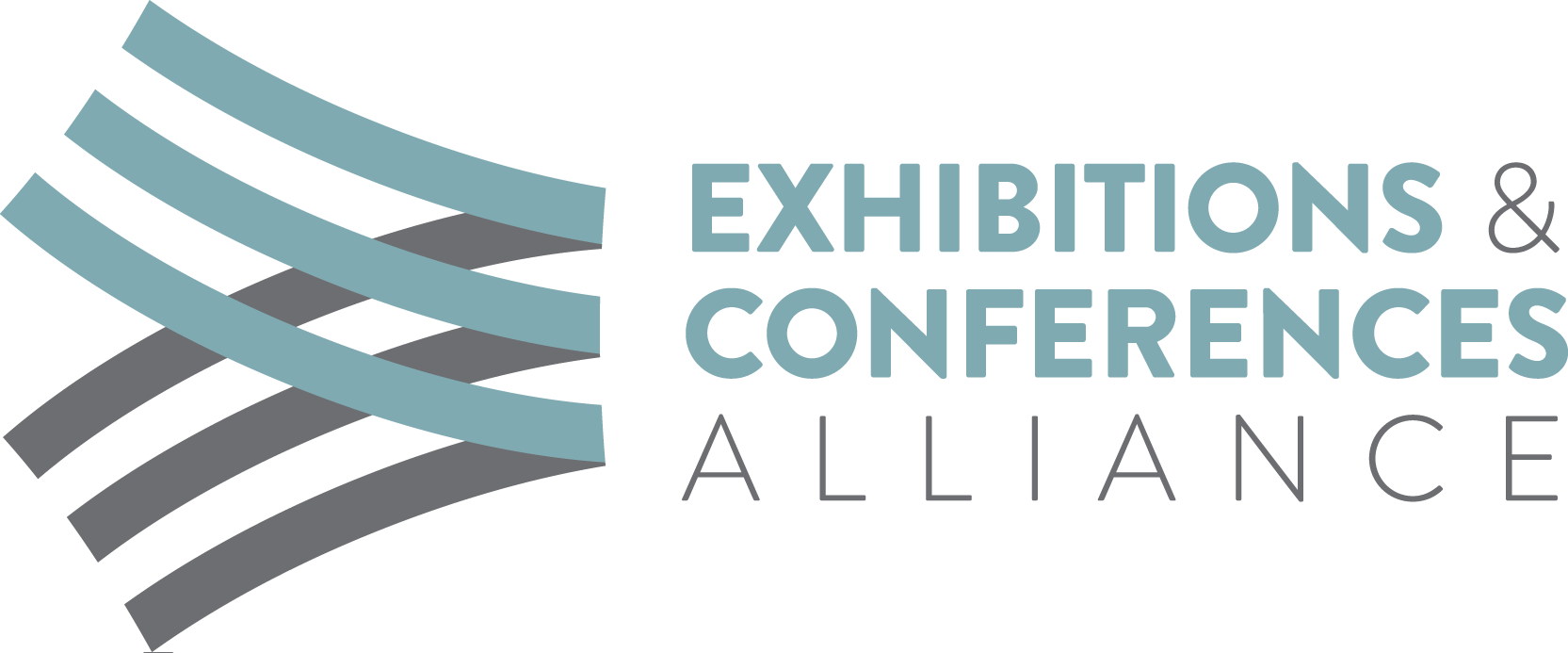ECA and its public policy counsel, Brownstein Hyatt Farber Schreck, LLP, have prepared the following detailed analysis of recent tariff developments and what they mean for the business and professional events industry. Please bookmark this page for future updates as circumstances warrant.
UPDATE: AUGUST 8, 2025
In recent weeks, U.S.-India trade relations have shown signs of strain. Once considered a leading candidate for an early bilateral trade agreement, India will soon face a minimum 50% tariff, positioning it as one of the most heavily penalized countries under the reciprocal tariff framework.
Below outlines the recent executive order (EO), which codifies the increased duty on India.
ADDRESSING THREATS TO THE UNITED STATES BY THE GOVERNMENT OF THE RUSSIAN FEDERATION (Executive Order, Fact Sheet)On July 31, President Trump issued an EO to update the “reciprocal” tariffs imposed under the International Emergency Economic Powers Act (IEEPA), which among other things established a 25% tariff on Indian goods beginning on Aug. 7—a modest decrease from the 27% tariff proposed on “Liberation Day.” However, President Trump later warned that India would be subject to the 25% “reciprocal” tariff as well as an additional “penalty” of 25%, citing concerns about the nation’s extensive trade barriers and purchase of Russian oil and military equipment. The president’s actions reflect a “secondary tariff” strategy designed to force U.S. trading partners to cut ties with U.S. adversaries.
This EO codifies the “penalty,” effectively doubling the tariff on India.
- Imposed Under IEEPA. In 2022, President Joe Biden invoked IEEPA to prohibit the United States from importing Russian energy resources or investing in the Russian energy sector to address the threat posed by Russia’s invasion of Ukraine. This EO maintains and expands the scope of the national emergency to address India’s direct or indirect importation of Russia oil.
- Increased Tariff. Indian goods entered for consumption, or withdrawn from warehouse for consumption, on or after 12:01 a.m. EDT on Aug. 26 will be subject to an additional 25% tariff.
- Stacking. The additional 25% duty imposed on Indian imports will apply in addition to any other duties, fees, taxes, exactions and charges applicable to such imports, including the 25% tariff announced on July 31. Thus, Indian goods will be subject to a minimum 50% tariff starting on Aug. 27.
- Exemptions. The following exemptions apply:
- Goods entered for consumption by Sept. 17. Indian goods that (1) were loaded onto a vessel at the port of loading and in transit on the final mode of transit prior to entry into the United States before 12:01 a.m. EDT on Aug. 26; and (2) are entered for consumption, or withdrawn from warehouse for consumption, before 12:01 a.m. EDT on Sept. 17, 2025, will not be subject to the additional 25% duty.
- Steel, aluminum, autos, copper and other sectors subject to current or future Section 232 “sectoral” tariffs. This EO does not modify the existing exemptions for goods subject to current and future “sectoral” tariffs implemented under Section 232 of the Trade Expansion Act of 1962. These tariffs currently apply to steel, aluminum, autos and copper, with pharmaceuticals, lumber and semiconductors currently subject to Section 232 investigations, which are likely to result in the imposition of future tariffs.
- Annex II. The exemptions outlined in Annex II of the “Liberation Day” EO remain in effect. These are largely agricultural, pharmaceutical and industrial inputs.
The Aug. 27 implementation timeline will provide an opportunity for the United States and India to continue bilateral trade negotiations. Separately, President Trump has considered a similar “secondary tariff” strategy as part of his trade negotiations with China and other countries that purchase Russian oil.
UPDATE: AUGUST 1, 2025
During the last week of July, President Trump issued a series of tariff-related executive actions:
- FURTHER MODIFYING THE RECIPROCAL TARIFF RATES: This Executive Order (EO) updates the “reciprocal” tariff rates imposed under the International Emergency Economic Powers Act (IEEPA), including to reflect the trade deals and tariff letters that the administration has reached with or sent to certain trading partners in recent weeks. A separate but related fact sheet also maintains a minimum reciprocal tariff rate of 10% for countries not covered in the EO.
- AMENDMENT TO DUTIES TO ADDRESS THE FLOW OF ILLICIT DRUGS ACROSS OUR NORTHERN BORDER: This EO increases the trafficking tariff imposed under IEEPA on imports from Canada from 25% to 35%; however, goods that satisfy rules of origin under the United States-Canada-Mexico Agreement (USMCA) will remain exempt from this tariff.
- ADDRESSING THREATS TO THE UNITED STATES BY THE GOVERNMENT OF BRAZIL: This EO imposes an additional 40% tariff under IEEPA on imports from Brazil in response to specific actions taken by the government of Brazil. This tariff applies in addition to the 10% “reciprocal” tariff on imports from Brazil for a cumulative rate of 50%; however, the EO lays out significant exemptions that apply to the additional 40%.
- ADJUSTING IMPORTS OF COPPER INTO THE UNITED STATES: This proclamation imposes a 50% tariff on imports of semi-finished copper products and intensive copper derivative products into the United States under Section 232 of the Trade Expansion Act of 1962.
- SUSPENDING DUTY-FREE DE MINIMIS TREATMENT FOR ALL COUNTRIES: This EO suspends duty-free “de minimis” treatment for low-value shipments entering the United States regardless of their origin. It builds on an earlier Trump administration EO that suspended “de minimis” for goods from China. The One Big Beautiful Bill Act (OBBBA, Pub.L 119-21) sunsets the “de minimis” exemption in July 2027, a date this EO effectively moves forward.
The actions came before the Aug. 1 deadline that the president had set for trading partners to reach trade deals with the United States. The “reciprocal” tariff EO is a key step in implementing the deals the administration reached prior to this deadline. It also implements the rates that the president notified certain trading partners of via a series of letters sent earlier this month.
Notably, President Trump did not issue an EO to modify tariffs on imports from Mexico. On July 31, the president posted on social media that he was granting Mexico a 90-day extension to allow negotiations to continue. During this period, Mexico will remain subject to a 25% trafficking tariff imposed under IEEPA, with an exemption for goods that satisfy USMCA rules of origin.
FURTHER MODIFYING THE RECIPROCAL TARIFF RATES (Executive Order, Fact Sheet)
This EO updates the “reciprocal” tariff rates imposed under the International Emergency Economic Powers Act (IEEPA), including to reflect the trade deals and tariff letters that the administration has reached with or sent to certain trading partners in recent weeks.
Previously, on April 2, or “Liberation Day,” President Trump issued an EO to impose a 10% baseline tariff on all nations as well as implement a country-specific reciprocal tariff regime. He later paused the implementation of the higher reciprocal tariffs until July 9, 2025, and then again until Aug. 1, 2025. However, the Trump administration emphasized that the deadline would not be extended past Aug. 1. The EO codifies, and in some cases modifies, the reciprocal tariff rates announced on “Liberation Day.”
- Imposed Under IEEPA. The president invoked the International Emergency Economic Powers Act (IEEPA, 50 U.S. Code § 1701) to impose tariffs to address the national security threat posed by the U.S. trade deficit.
- Country-Specific Tariff Rates. Starting on Aug. 7, the country-specific reciprocal tariff regime will replace the 10% “baseline” tariff for certain countries. The tariffs range from 15% to 41% and amend the rates assigned in Annex I on “Liberation Day.” Any nation not outlined below as part of Annex I will remain subject to the 10% baseline. The EO recognizes that negotiations are ongoing with several trading partners. However, such nations will remain subject to the new duties outlined below until such time that a formal agreement is reached.
- Transshipment. Any article determined to be transshipped to evade tariffs will be subject to a 40% tariff, in lieu of the applicable duty of the country of origin. Additionally, U.S. Customs and Border Protection (CBP) will impose appropriate fines and penalties as well as other duties, fees, taxes, exactions or charges applicable to goods of the country of origin.
- Additional Details:
- Goods Entered for Consumption by Oct. 5, 2025. Goods loaded onto a vessel at the port of loading and in transit on the final mode of transit before 12:01 a.m. EDT seven days after the date of this order, and entered for consumption, or withdrawn from warehouse for consumption, before 12:01 a.m. EDT on Oct. 5, 2025, will not be subject to the additional duty. Rather, the goods will be subject to the rates assigned on “Liberation Day.”
- European Union (EU). The dual EU rates in the chart below are structured to effectively increase existing U.S. tariffs on EU goods to 15%, while not applying any additional duties on EU goods that are already subject to tariffs above 15%. The administration will have to take further action to apply the 15% rate to “autos and auto parts, pharmaceuticals, and semiconductors,” three sectors that are subject to current or pending tariffs under Section 232 of the Trade Expansion Act of 1962.
- Services. Reciprocal tariffs currently do not apply to services contracts (e.g., professional services) or similar arrangements. The administration’s focus on goods over services reflects President Trump’s broader goal of revitalizing U.S. manufacturing.
- Canada and Mexico. The two countries are not subject to these “reciprocal” tariffs. For both nations, the trafficking-based tariffs continue to apply with exemptions for imports that meet USMCA rules of origin.
- Steel, aluminum, autos, copper and other sectors subject to current or future Section 232 “sectoral” tariffs. This EO does not modify the existing exemptions for goods subject to current and future “sectoral” tariffs implemented under Section 232 of the Trade Expansion Act of 1962. These tariffs currently apply to steel, aluminum, autos and copper with pharmaceuticals, lumber and semiconductors currently subject to Section 232 investigations, which are likely to result in the imposition of future tariffs.
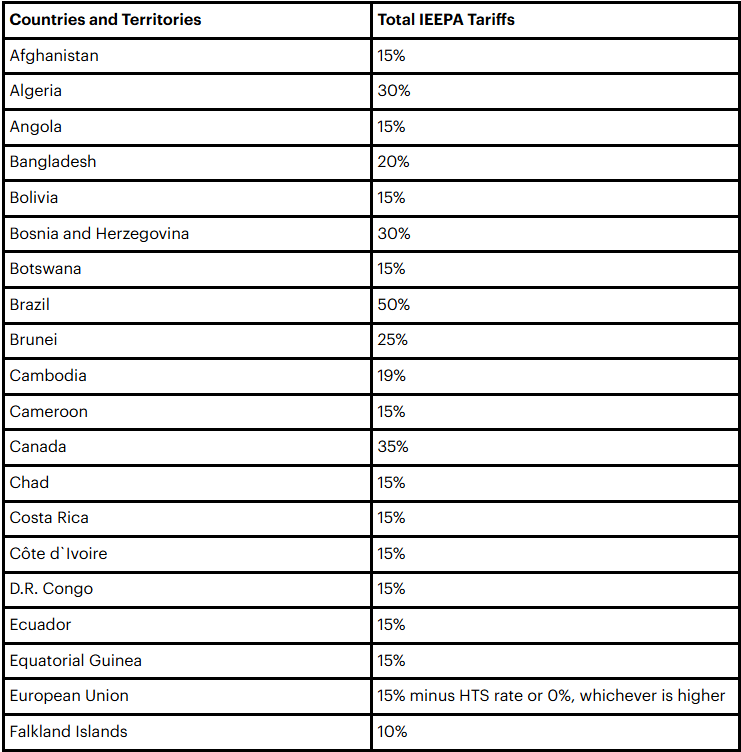
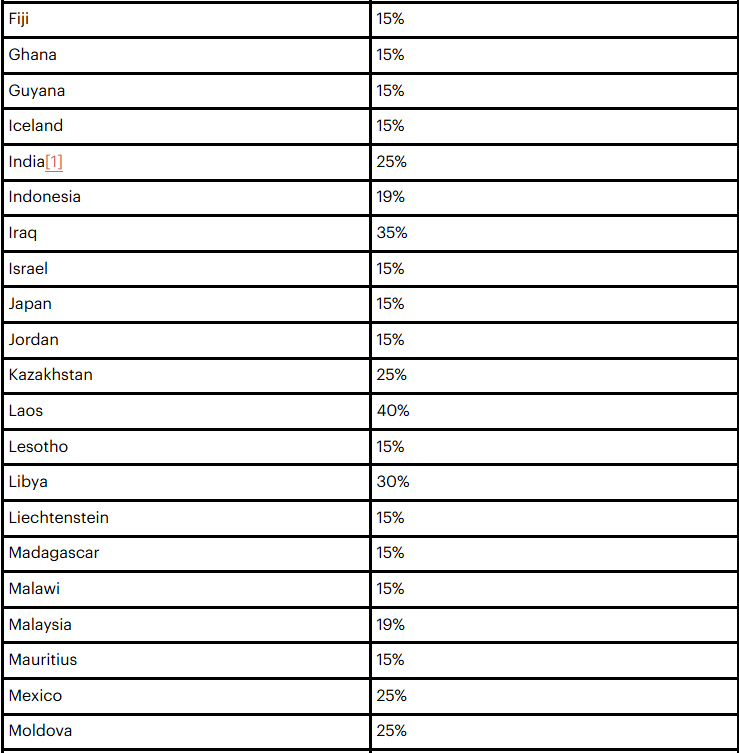
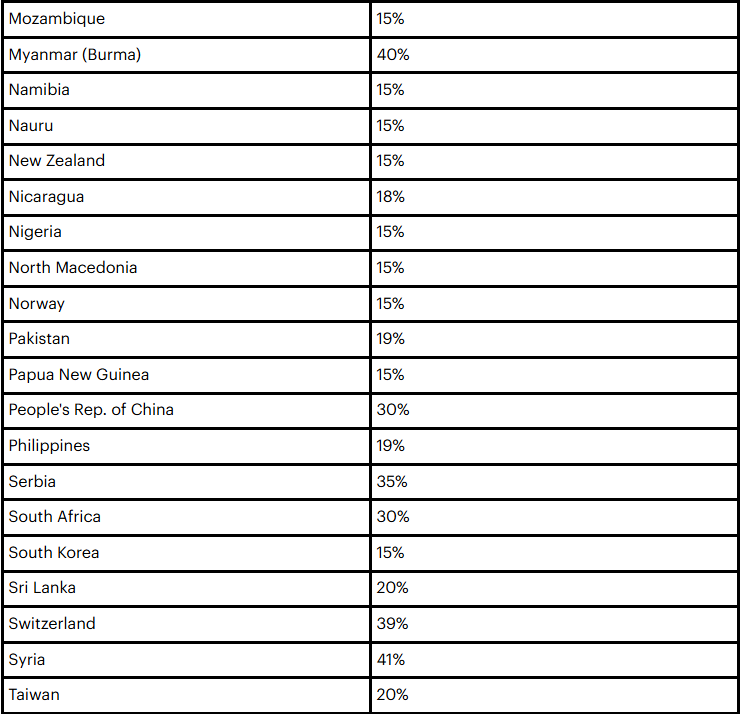
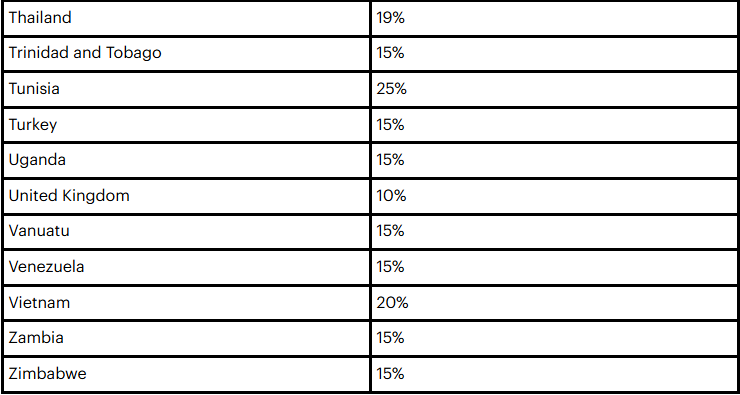
** Any nation not listed above remains subject to the 10% baseline tariff rate.
AMENDMENT TO DUTIES TO ADDRESS THE FLOW OF ILLICIT DRUGS ACROSS OUR NORTHERN BORDER (Executive Order, Fact Sheet)
This EO updates the trafficking tariff imposed under IEEPA on imports from Canada from 25% to 35%; however, goods that satisfy rules of origin under the USMCA will remain exempt from this tariff.
Previously, on Feb. 1, President Trump issued a series of EOs to impose a 25% tariff on Mexico and Canada and a 10% tariff on Canadian energy resources. The administration formally cited Canada and Mexico’s failure to stop illicit immigration and shipments of deadly drugs such as fentanyl into the United States as the reason for imposing the tariffs. These tariffs went into effect on March 4, but the president signed an EO on March 6 temporarily exempting goods that satisfy USMCA rules of origin or that claim and qualify for USMCA preference.
On July 31, President Trump announced that all Mexican goods that do not satisfy USMCA rules of origin will remain subject to a 25% tariff for the next 90 days, as the countries negotiate a trade deal. Mexico will also remain subject to the Section 232 tariffs on steel, aluminum, autos and copper. However, the president issued an EO to increase the tariff on Canada, citing concerns that the nation failed to curb fentanyl shipments and implemented retaliatory tariffs.
- Imposed Under IEEPA. The president invoked IEEPA to increase the duty on Canadian goods from 25% to 35%. This EO does not appear to modify the 10% rate on Canadian energy resources. The increased duty will apply to goods entered for consumption, or withdrawn from warehouse for consumption, on or after 12:01 a.m. EDT on Aug. 1, 2025.
- USMCA Preference. Goods that satisfy USMCA rules of origin will remain exempt from trafficking tariffs.
- Transshipment. Any article determined to be transshipped to Canada to evade tariffs will be subject to a 40% tariff, in lieu of the 35% rate assigned to Canada. Additionally, U.S. Customs and Border Protection (CBP) will impose appropriate fines and penalties as well as other duties, fees, taxes, exactions or charges applicable to goods of the country of origin.
ADDRESSING THREATS TO THE UNITED STATES BY THE GOVERNMENT OF BRAZIL (Executive Order, Fact Sheet)
This EO imposes an additional 40% tariff under IEEPA on imports from Brazil in response to specific actions taken by the government of Brazil, effective on Aug. 7. This tariff is in addition to the 10% “reciprocal” tariff on imports from Brazil for a cumulative rate of 50%; however, the EO lays out significant exemptions that apply to the additional 40%.
Previously, on July 9, President Trump sent Brazil a letter, stating that he will dramatically increase the “reciprocal” tariff on Brazil from the 10% “baseline” to 50%. The president cited concerns about the trial of former President Jair Bolsonaro, who allegedly sought to overturn the results of the 2022 presidential election, as well as recent Brazilian efforts to target U.S. technology companies.
- Imposed Under IEEPA. The president invoked IEEPA to impose an additional ad valorem duty rate of 40% on Brazilian imports outlined in Annex II of the EO. It is estimated that Annex II accounts for roughly a third of Brazilian exports to the United States. Brazil’s Ministry of Development, Industry, Trade and Services is set to report an official figure shortly.
- 10% Baseline Remains In Effect. The 10% baseline tariff, which became effective on April 5, 2025, remains in effect on Brazilian goods, bringing the minimum duty rate to 50% for goods entered for consumption, or withdrawn from warehouse for consumption, on or after 12:01 a.m. EDT on Aug. 6, 2025. The tariff will apply in addition to all existing duties on Brazilian goods.
- Exemptions. This EO exempts a list of articles outlined in its Annex I, including certain silicon metal, pig iron, civil aircraft and parts and components thereof, metallurgical grade alumina, tin ore, wood pulp, precious metals, energy and energy products and fertilizers. Additionally, this EO does not apply to imports subject to current and future sector-specific “reshoring” tariffs implemented under Section 232 of the Trade Expansion Act of 1962 (19 U.S. Code § 1862). This currently includes steel, aluminum, autos and copper. However, pharmaceuticals, lumber and semiconductors, among other goods, are currently subject to Section 232 investigations, which are likely to result in the imposition of future tariffs, potentially leaving such goods exempted from the 50% reciprocal duty.
- Retaliation. The EO warns that, if the Brazilian government imposes retaliatory tariffs, President Trump will increase the duty on Brazilian goods by the corresponding amount. Brazilian President Luiz Inácio Lula da Silva has been openly critical of the Trump administration’s trade policies, but it remains unclear how the Brazilian government will respond to the increased duty.
ADJUSTING IMPORTS OF COPPER INTO THE UNITED STATES (Proclamation, Fact Sheet)
This proclamation imposes a 50% tariff on imports of semi-finished copper products and intensive copper derivative products into the United States under Section 232 of the Trade Expansion Act of 1962. Notably, the tariff will not apply to refined copper until at least 2027, allowing U.S. producers of products that include copper to retain duty-free access to input material.
Previously, on Feb. 25, President Trump issued an EO directing the secretary of commerce to initiate a Section 232 investigation on whether the importation of copper and derivative products undermines national security. Section 232 of the Trade Expansion Act of 1962 (19 U.S. Code § 1862) empowers the Department of Commerce’s Bureau of Industry and Security (BIS) to determine if the importation of a product threatens the national security of the United States. The EO directed the secretary of commerce to review the state of copper production, smelting, refining and recycling domestically and abroad and report on whether foreign governments are engaging in anticompetitive practices that undermine U.S. production.
On June 30, Commerce Secretary Howard Lutnick submitted a report to the president outlining the national security risks associated with copper import dependency and recommending appropriate actions, including tariffs.
- 50% Tariff. Based on the Commerce Department’s findings, President Trump determined that a 50% tariff must be applied to all imports of semi-finished copper products and intensive copper derivative products, as set forth in the Annex. The duty will apply to the outlined products entered for consumption, or withdrawn from warehouse for consumption, on or after 12:01 a.m. EDT on Aug. 1, 2025. The tariff will apply in addition to any preexisting duties. The secretary of commerce is directed to establish a process by which additional derivative copper articles will become subject to the 50% duty within 90 days.
- Exemptions. The 50% duty will only apply to the copper content of a given product. Non-copper content will remain subject to reciprocal tariffs or other applicable duties based on the country of origin. The 50% copper tariff will not apply in addition to the 25% tariff on automobiles and related parts. If an automobile contains copper content, it will be subject to the 25% auto tariff, not the copper tariff.
- United Kingdom (UK). In accordance with the United States of America and the United Kingdom of Great Britain and Northern Ireland Economic Prosperity Deal, copper imports from the UK are exempt from the 50% duty as the nations work to establish a secure supply chain.
- Domestic Production. The EO authorizes the secretary of commerce under the Defense Production Act (DPA) to require 25% of high-quality copper scrap, including copper ores, concentrates, mattes, cathodes and anodes, produced in the United States to be sold domestically, beginning in 2027. The percentage will increase to 30% in 2028 and 40% in 2029. The policy is intended to enhance the domestic copper industry by ensuring adequate inputs are available for refining operations.
SUSPENDING DUTY-FREE DE MINIMIS TREATMENT FOR ALL COUNTRIES (Executive Order, Fact Sheet)
This EO suspends duty-free “de minimis” treatment for low-value shipments entering the United States regardless of their origin. The de minimis provision is often used by e-commerce companies as it currently allows goods valued at or under $800 to enter the United States duty-free. This EO builds on an earlier Trump administration EO that suspended “de minimis” for goods from China. OBBBA sunsets the “de minimis” exemption in July 2027, a date this EO effectively moves forward.
- Revocation. The de minimis exemption will no longer apply to any import entering the United States, regardless of value, country of origin, mode of transportation or method of entry. The imports will be subject to all applicable duties, taxes, fees, exactions and charges.
- Effective Date. All goods entered for consumption, or withdrawn from warehouse for consumption, on or after 12:01 a.m. EDT on Aug. 29, 2025, will no longer be eligible for de minimis entry.
- International Postal Network. Goods shipped through the international postal network that would otherwise qualify for the de minimis exemption will be subject to duties as outlined below:
- For the first six months after the policy goes into effect, such goods will be subject to a duty up to $200 per item, depending on the IEEPA rates applicable to the country of origin of the product.
- Countries with an effective IEEPA tariff rate of less than 16%: $80 per item;
- Countries with an effective IEEPA tariff rate between 16%-25%: $160 per item; and
- Countries with an effective IEEPA tariff rate above 25%: $200 per item.
- After six months, a duty equal to the effective IEEPA tariff rate applicable to the country of origin of the product shall be assessed on the value of each package containing goods entered for consumption.
- Travel and Gifts. American travelers can still bring back up to $200 in personal items, and individuals can continue to receive bona fide gifts valued at $100 or less duty-free.
UPDATE: JULY 25, 2025
As of July 25, President Donald Trump has announced five bilateral trade deals, setting new tariff rates for the countries involved that the president intends to make effective on Aug. 1.
Indonesia: Joint Statement, Fact Sheet
On July 15, President Trump announced that the United States and Indonesia had reached a deal. The two countries then released a Joint Statement with details of the agreement. Indonesian imports will be subject to a 19% tariff — a decrease from the proposed 32% duty included in the letter sent to the nation on July 7. In exchange, Indonesia agreed to remove all tariffs and non-tariff barriers undermining U.S. market access, specifically for U.S. agricultural, transportation, medical and manufacturing industries.
Additional commitments include:
- Strengthening rules of origin requirements to limit transshipment;
- Eliminating rules and regulations targeting U.S. digital services companies;
- Securing supply chains in strategic sectors, including steel, critical minerals and other industrial commodities;
- Improving labor standards through a ban on forced labor; and
- Investing in the United States through the purchase of $15 billion worth of U.S. Energy, $4.5 billion in U.S. agricultural goods and 50 Boeing aircraft.
Japan: Fact Sheet
On July 22, President Trump announced that the United States and Japan had reached a deal. Japanese imports will be subject to a 15% tariff—a decrease from the proposed 25% duty included in the letter sent to the nation on July 7. In exchange, Japan agreed to enhance U.S. market access. Japanese officials have confirmed key elements of the agreement.
Additional commitments include:
- Investing $550 billion in the United States, which President Trump says will be used to expand domestic manufacturing; and
- Increasing imports of key American goods, including agricultural products, automobiles, commercial aircraft, defense equipment and energy.
Philippines:
On July 22, President Trump announced that the United States and the Philippines had reached a deal. According to the announcement, Philippine imports will be subject to a 19% tariff—a decrease from the proposed 20% tariff duty included in the letter sent to the nation on July 9. In exchange, the Philippines agreed to eliminate tariffs on U.S. exports and enhance defense coordination.
The White House has yet to release formal details regarding the agreement. Ambassador of the Philippines to the United States Jose Manuel Romualdez said the Philippines government will continue to negotiate to lower tariffs on its exports to 15%.
Vietnam:
On July 2, President Trump announced that the United States and Vietnam had reached a deal. According to the announcement, Vietnamese imports will be subject to a 20% tariff—a decrease from the 46% tariff proposed on “Liberation Day.” However, goods transshipped from other countries, namely China, will be subject to a 40% tariff. In exchange, the president announced that Vietnam agreed to remove all tariffs on American imports and provide the United States greater market access.
The White House has yet to release formal details regarding the agreement. The Vietnamese government has not confirmed its participation in the agreement.
United Kingdom: Executive Order, Fact Sheet,
On June 16, President Trump issued an executive order (EO) to codify the general terms of the United States of America and the United Kingdom (UK) of Great Britain and Northern Ireland Economic Prosperity Deal reached on May 8. UK imports are subject to the 10% baseline tariff. In exchange, the deal exempts the UK from various product-specific tariffs on the condition that the country secures its supply chain in strategic sectors.
Specifically, the deal:
- Lowers the 25% tariff on automobiles and parts to 10% for the first 100,000 cars imported into the United States;
- Exempts UK aircraft and related parts from being subject to the reciprocal tariffs and tariffs on steel and aluminum; and
- Exempts the UK from the 50% tariff on steel and aluminum, pending the secretary of commerce’s establishment of a tariff-rate quota. Notably, steel, aluminum and their derivative articles in excess of the established tariff-rate quota will be subject to the 50% tariff. Tariffs on UK steel and aluminum currently remain at 25%.
The EO does not codify other aspects of the general terms, such as the creation of a secure pharmaceutical supply chain and increased market access for U.S. agricultural products, setting the stage for additional negotiations.
UPDATE: JULY 24, 2025
On July 24, the European Union (EU) agreed to a retaliation strategy in case it is unable to reach a trade deal with the United States. All member countries, except Hungary, supported the imposition of a retaliatory tariff package on €93 billion worth of American goods. The maximum tariff to be imposed will be 30%, targeting U.S. agricultural products, aircraft, automobiles and other industrial goods. The retaliatory tariffs will go into effect on Aug. 7, providing time to negotiate before the Aug. 1 deadline.
The European Commission has maintained its commitment to reaching a deal with the United States. In recent days, the Trump administration has expressed optimism about the likelihood of a U.S.-EU deal being reached, following European Commission President Ursula von der Leyen’s visit to Washington. Treasury Secretary Scott Bessent said negotiations “are going better,” but was hesitant about the likelihood of the EU’s tariff being lowered to 15%, which the bloc is pushing for in light of the U.S.-Japan deal. On July 25, President Trump told reporters that there is a 50-50 chance that the United States reaches a deal with the EU, indicating that key issues remain unresolved.
UPDATE: JULY 17, 2025
On July 16, President Donald Trump said he plans on sending a letter to more than 150 countries, with which the United States does minimal business, informing them of what tariff rate they will face. “It’s all going to be the same for everyone, for that group,” Trump told reporters. Over the past few weeks, Trump has sent roughly two-dozen letters informing the United States’ largest trade partners of the tariff rate they will face effective Aug. 1. These include countries like China, Japan, South Korea and the European Union (EU). Currently, all countries are paying an additional baseline tariff of 10% that Trump set in April. While Trump is continuing tariff negotiations, he is also urging the Supreme Court to reject a challenge seeking to undo his tariff regime. Learning Resources Inc. and hand2mind, two toy companies, argue that Trump’s reciprocal tariffs exceed the president’s powers under the International Emergency Economic Powers Act (IEEPA).
UPDATE: JULY 11, 2025
On July 7, President Trump began sending letters to select U.S. trading partners informing them of new “reciprocal” tariff rates that will be effective August 1. These letters update the rates that the recipient country was assessed on “Liberation Day,” April 2, 2025.
A White House fact sheet, published on July 7, explained that “the President may send more letters in the coming days and weeks” and “in some instances, countries will be subject to a revised reciprocal tariff rate that is lower than the rate initially announced on April 2. For others, the reciprocal tariff rate may be higher than the previous rate.” While the letters make clear that President Trump will “perhaps” consider “adjustments to this letter,” the letters take a hardline approach and imply that the updated rates will go into effect unless countries open “closed” markets.
As of July 11, 23 nations have received letters. Many of the letters include relatively minor changes to the tariff rates announced on “Liberation Day.” For example, Japan and South Korea will both be subject to a 25% tariff instead of 24% and 26%, respectively. Several countries received substantially lower rates. For example, Cambodia, Iraq, Laos and Sri Lanka’s rates were lowered by more than 8%, with Sri Lanka receiving the highest decrease from 44% to 30%. However, the letters received by these countries all contain the same language, which does not address the reasoning behind each rate adjustment.
On July 9, President Trump sent Brazil a letter stating he will dramatically increase “reciprocal” tariffs on Brazil from the 10% “baseline” to 50%, effective August 1. The letter sent to Brazil differs from the others, citing concerns about the trial of former President Jair Bolsonaro, who sought to overturn the results of the 2022 presidential election, as well as recent Brazilian efforts to target U.S. technology companies.
On July 10, President Trump sent Canada a letter stating that he will impose a 35% tariff on the country effective August 1. This letter accuses Canada of retaliating against the 25% tariffs President Trump imposed earlier this year in response to the fentanyl crisis and imposing tariffs of 400% on U.S. dairy imports. Canada was not given a “reciprocal” tariff on “liberation Day.” Imports from Canada that are compliant with the United States-Mexico-Canada Agreement (USMCA) are currently exempt from the 25% tariff. On July 11, President Trump responded “We’re going to see” in response to a question from a reporter on whether this exemption would apply to the new 35% rate.
All of the letters, including those sent to Brazil and Canada, note that these updated “reciprocal” tariffs are “separate” from “sectoral” tariffs—almost certainly a reference to those that can be imposed after an investigation under Section 232 of the Trade Expansion Act of 1962. These “sectoral” tariffs currently apply to a range of products, including steel, aluminum and autos. The administration has launched 232 investigations into a range of other products including pharmaceuticals, semiconductors (including smartphones as “derivative products”), copper, timber and lumber, and critical minerals. Many products that are the subject of Section 232 investigations are currently exempt from “reciprocal” tariffs.
The “reciprocal” tariffs and the “sectoral” tariffs generally do not apply on top of each other; however, how the two tariff categories interact when applied to specific products, such as those containing steel and aluminum, can involve a detailed analysis. The Trump administration has not publicly addressed whether exemptions for “critical minerals” and other products, which are the subject of ongoing Section 232 investigations, will be applied to the updated “reciprocal” tariffs; however, maintaining this exemption would be consistent with how the Trump administration has imposed tariffs to date as well as the notion that “sectoral” and “reciprocal” tariffs are “separate.”
On July 7, President Trump signed an executive order (EO) extending the pause on “reciprocal” tariffs that was set to expire on July 9 to August 1. The EO does not formally implement the updated tariff rates included in the letters discussed above. Implementing these updated rates will require additional action from the administration. As a result, most U.S. trading partners will continue to be subject to a 10% “baseline” tariff through August 1, regardless of whether or not they have received a letter. Canada will remain subject to a 25% tariff with the USMCA exemption in place through this date.
Here is a chart with some of the "receiprocal" tariff rate changes announced snce July 7:
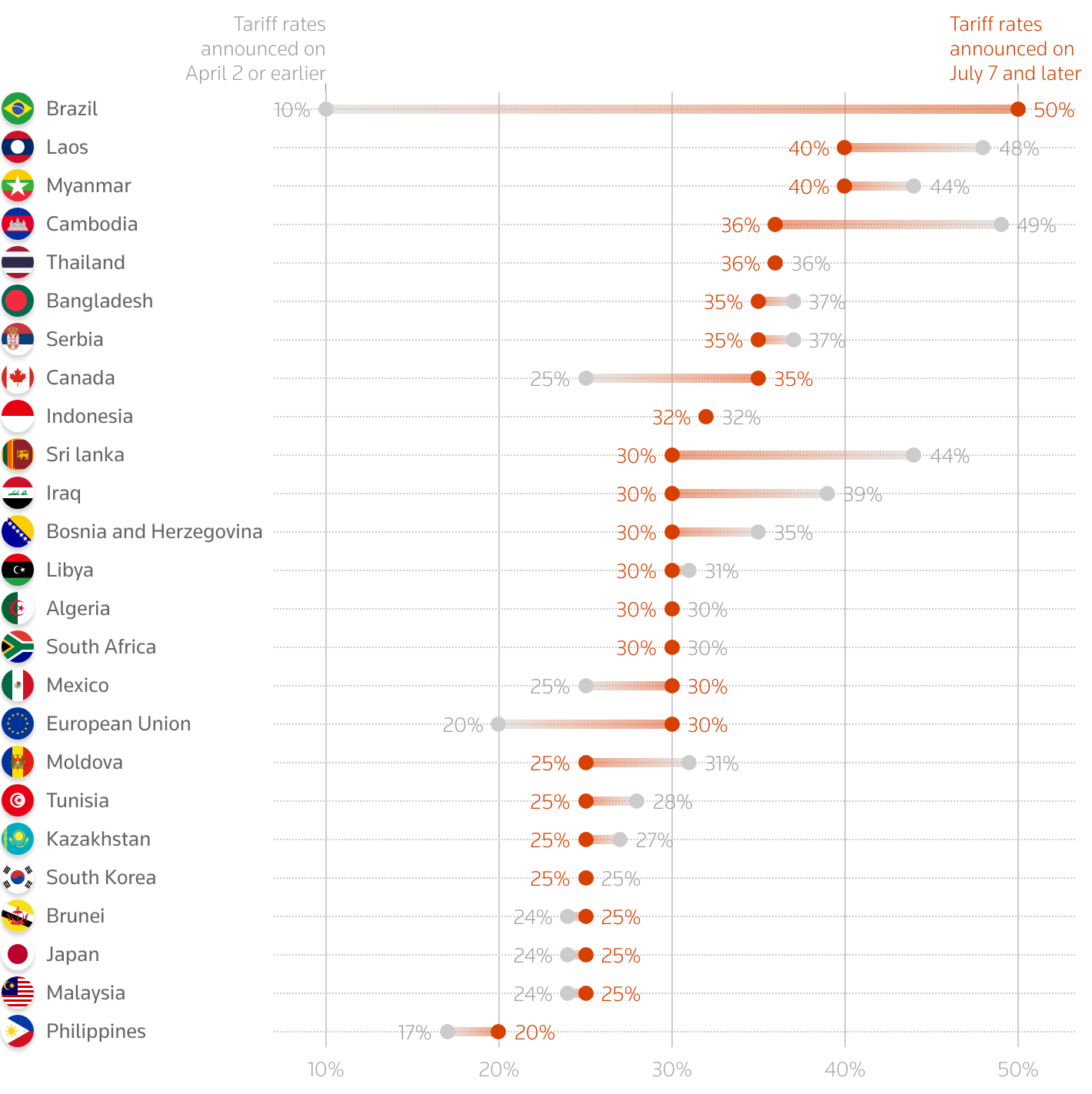
UPDATE: JUNE 3, 2025
On June 3, President Donald Trump issued a proclamation to increase duties on steel, aluminum and their derivative products from 25% to 50%, effective June 4, 2025. The president invoked Section 232 of the Trade Expansion Act of 1962 to adjust the duties, citing concerns that the existing duty rates were not effectively mitigating the threat to national security. A White House Fact Sheet provides further background on the increased tariffs.
The proclamation also modifies the way in which tariffs apply to imported products containing steel and aluminum. Under the new approach, the 50% steel and aluminum tariffs apply to the steel and aluminum contents of a product, while the non-steel and non-aluminum content of that same product is subject to the “reciprocal” or “baseline” tariff rate—currently 10%. Previously, products that were subject to the steel and aluminum tariff were not subject to the “reciprocal” or “baseline” tariff. The additional 20% “fentanyl” or “trafficking” tariff on imports from China still applies to the full value of such products.
The United Kingdom (UK) is exempt from the increased steel and aluminum tariffs with covered imports facing the preexisting 25% tariff due to the U.S.-UK Economic Prosperity Deal (EDP) signed on May 8, 2025. On or after July 9, the secretary of commerce has the authority to adjust the tariffs applied to UK steel and aluminum as well as institute import quotas consistent with the terms of the EPD.
This action serves as a reminder that the administration will use the full range of tariff authorities at its disposal.
UPDATE: MAY 30, 2025
Within the span of 24 hours, two federal court orders further increased uncertainty around President Trump’s tariff regime. On May 28, the U.S. Court of International Trade (USCIT) unanimously issued a permanent injunction blocking enforcement of the Trump administration’s 10% “baseline” tariff, higher country-specific “reciprocal” tariffs and the additional “fentanyl” tariffs imposed under the International Emergency Economic Powers Act (IEEPA, 50 U.S. Code § 1701), and ordered the administration to rescind the relevant executive orders within 10 days.
Then, on May 29, Judge Rudolph Contreras of the U.S. District Court for the District of Columbia issued a preliminary injunction restricting the administration from imposing IEEPA-based tariffs on two specific plaintiffs, Learning Resources, Inc. and hand2mind, Inc. [UPDATE: The appeals court issued a longer stay on the USCIT's decision, which will likely keep the IEEPA tariffs in effect until at least July 31.]
Later on May 29, the United States Court of Appeals for the Federal Circuit temporarily stayed the USCIT decision—keeping the tariffs in effect. The appeals court set a deadline of June 5 for responses to the government’s motion for a longer stay, making it likely that the temporary stay will remain in effect until at least June 9, 2025. At that point, the appeals court will determine whether to issue a longer stay that would keep the tariffs in effect until that court rules on the merits. Regardless of the outcome, the appeals court’s decision is likely to be appealed to the Supreme Court.
The two court orders do not affect the tariffs imposed on specific sectors including steel, aluminum and autos under Section 232 of the Trade Expansion Act of 1962. These will remain in effect regardless of how this legal process plays out. The orders will also not impact the sector-specific tariffs that the Trump administration is expected to impose under Section 232 in the near future on pharmaceuticals, critical minerals and semiconductors/smartphones. Finally, they do not impact the tariffs imposed on China under Section 301 of the Trade Act of 1974 during President Trump’s first term.
UPDATE: APRIL 18, 2025
On April 17, the Office of the United States Trade Representative took action on the "Section 301 Investigation of China’s Targeting of the Maritime, Logistics, and Shipbuilding Sectors for Dominance to eliminate China’s acts, policies, and practices targeting the maritime, logistics, and shipbuilding sectors for dominance."
For the first 180 days, applicable fees will be set a zero.
In the first phase actions, after 180 days:
- Fees on vessel owners and operators of China based on net tonnage per U.S. voyage, increasing incrementally over the following years - the fee would start at $50/NT in 180 days and increases by $30/NT per year over the next three years;
- Fees on operators of Chinese-built ships based on net tonnage or containers, increasing incrementally over the following years - the fee would start at $18/NT or $120 per container in 180 days, and would increase by $5/NT per year, or the same proportional yearly amount per container (e.g., in year 2, to $154 per container), over the next three years; and
- To incentivize U.S.-built car carrier vessels, fees on foreign-built car carrier vessels based on their capacity - the fee would start at $150 per Car Equivalent Unit (CEU) capacity of the entering non-U.S. built vessel in 180 days.
The second phase actions will not begin for 3 years:
- To incentivize U.S.-built liquified natural gas (LNG) vessels, limited restrictions on transporting LNG via foreign vessels. These restrictions will increase incrementally over 22 years.
Furthermore,
- Fees on Chinese vessel operators and owners and Chinese-built ships are assessed per U.S. voyage, not per port call. These fees are imposed on a given ship no more than five times per year.
- Fees are not “stacked,” meaning only one fee will be assessed per U.S. voyage.
- Upon proof of order of a U.S.-built vessel, fees or restrictions on an equivalent non-U.S.-built vessel are suspended for up to three years.
- Fees on Chinese-built ships effectively do not cover Great Lakes or Caribbean shipping, shipping to and from U.S. territories, or bulk commodity exports on ships that arrive in the United States empty.
UPDATE: APRIL 16, 2025
On April 11, President Donald Trump issued a memorandum to clarify that smartphones and certain other electronics are not subject to the now-125% “reciprocal” tariff on imports from China or the 10% “baseline” tariff on imports from most other trading partners. Customs and Border Protection issued a related guidance late that evening. Specific products covered by the April 11 memorandum are listed below.
The memorandum spares covered imports from the “reciprocal” and “baseline” tariffs by expanding an existing carveout for semiconductors. However, the president and Commerce Secretary Howard Lutnick have indicated that these goods will soon be subject to sector-specific “reshoring” tariffs levied under Section 232 of the Trade Expansion Act of 1962. The administration began the process of imposing these tariffs on April 14.
The products listed in the memorandum remain subject to the 20% tariff on imports from China imposed in response to the fentanyl crisis. Imports of these products from Canada and Mexico that do not qualify under the United States-Mexico-Canada Agreement (USMCA) also remain subject to a 25% tariff.
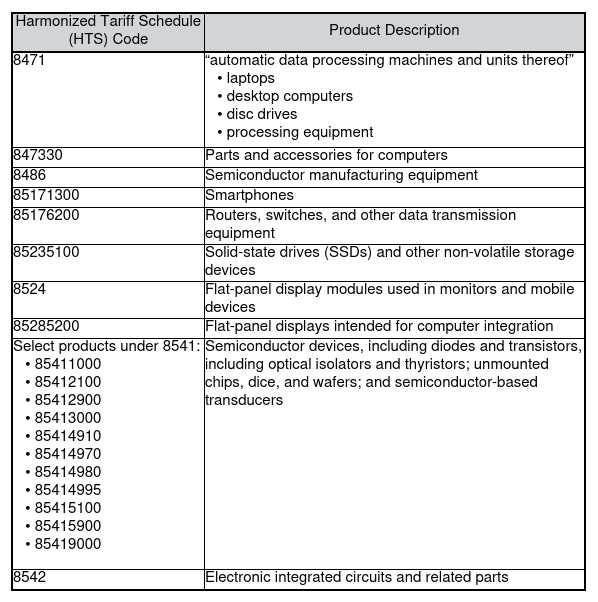
UPDATE: APRIL 10, 2025
On April 9, President Donald Trump signed an executive order (EO) to (1) pause the imposition of the higher country-specific reciprocal tariffs on all countries except China while leaving the broad 10% reciprocal tariff rate in effect and (2) further increase the reciprocal duty rate imposed on Chinese goods.
The EO suspends the country-specific reciprocal tariffs, which went into effect on April 9 at 12:01 a.m. EDT, for all countries outlined in Annex I, except China.- These country-specific reciprocal tariffs (EO 14257) have been paused until 12:01 a.m. EDT on July 9, 2025.
- The baseline across-the-board 10% tariff imposed on all countries remains in place.
- The pause will apply to goods entered for consumption, or withdrawn from warehouse for consumption, on or after 12:01 a.m. EDT on April 10, 2025.
- Separately, the International Emergency Economic Powers Act (IEEPA) tariffs imposed on Canada (25%), Mexico (25%) and China (20%) remain in effect.
- This amended duty rate will continue to apply on top of other existing duties, including the 20% fentanyl tariffs, effectively bringing the tariff rate on Chinese goods to 145%. Select Chinese goods are also subject to Section 301 tariffs, which will further increase duty rates.
- While President Trump indicated in an April 9 post on Truth Social that the increased reciprocal tariff would take effect “immediately,” the EO clarifies that the higher rate formally went into effect at 12:01 a.m. EDT on April 10, 2025.
- The exclusions to the reciprocal tariffs enumerated in EO 14257 remain in effect and are outlined below.
UPDATE: APRIL 8, 2025
On April 8, President Donald Trump signed an executive order (EO) to further increase the reciprocal duty rate imposed on Chinese goods.
Today’s EO amends EO 14257, issued on April 2, to raise the reciprocal tariff on Chinese goods from 34% to 84%
- This amended duty rate will continue to apply on top of other existing duties, including the 20% fentanyl tariffs, effectively bringing the tariff rate on Chinese goods to 104%. Select Chinese goods are also subject to Section 301 tariffs, which will further increase duty rates.
- This increased reciprocal tariff will go into effect as previously scheduled on April 9 at 12:01 a.m. EDT.
- The exclusions to the reciprocal tariffs enumerated in EO 14257 remain in effect and are outlined below.
These changes are a response to the April 4 announcement from China’s State Council Tariff Commission that it would impose a 34% tariff on American goods, matching the original U.S. reciprocal duty rate, among other retaliatory actions.
UPDATE: APRIL 2, 2025
On April 2, President Donald Trump issued an executive order (EO) to impose reciprocal tariffs on select countries.
Executive Order Imposing Reciprocal and Baseline Tariffs (Executive Order, Fact Sheet)
- Imposed Under IEEPA. The president invoked the International Emergency Economic Powers Act (IEEPA, 50 U.S. Code § 1701) to levy the reciprocal tariffs, citing “conditions reflected in large and persistent annual U.S. goods trade deficits.” IEEPA was also the mechanism used to impose the existing fentanyl- and immigration-based tariffs levied on Mexico, Canada and China in February.
- Initial 10% Tariff. Starting on April 5 at 12:01 a.m. EDT, the EO imposes a baseline across-the-board 10% tariff on all countries; as noted below, these are imposed on top of all existing duty rates with the exception of goods from Mexico and Canada.
- Country-Specific Tariff Rates. Starting on April 9 at 12:01 a.m. EDT, a country-specific reciprocal tariff regime will replace the baseline 10% tariffs for certain countries. The reciprocal tariffs regime effectively identifies a tariff charged to the United States by a specific country that includes “currency manipulation and trade barriers”; that rate is halved to determine the “discounted reciprocal tariff” that the United States will impose on the country on April 9. Country-specific rates are outlined in Annex I.
- After the EO’s release, the White House later confirmed that the reciprocal tariffs are based on the large trade deficits these countries run with the United States; trade analysts argue that the formula is simply the trade deficit with a specific country divided by the country’s exports to the United States. The Office of the U.S. Trade Representative (USTR) subsequently released a methodology for calculating reciprocal tariffs, indicating that “the tariff rates that would drive bilateral trade deficits to zero were computed.”
- Exemptions. The reciprocal/baseline tariff regime currently does not apply to the following:
- Services. Reciprocal tariffs currently do not apply to services contracts (e.g., professional services) or similar arrangements. The administration’s focus on goods over services reflects President Trump’s broader goal of revitalizing U.S. manufacturing.
- Canada and Mexico. The two countries are not subject to the reciprocal or baseline tariffs. For both nations, the existing fentanyl-based tariffs — and United States-Mexico-Canada Agreement (USMCA) exemptions — continue to apply. If the fentanyl-based tariffs are revoked, the reciprocal EO states that non-USMCA goods will be subject to a 12% tariff.
- Steel, aluminum, autos, and other sectors subject to current or future Section 232 “Reshoring” tariffs. The EO exempts products subject to current and future sector-specific “reshoring” tariffs implemented under Section 232 of the Trade Expansion Act of 1962. This currently includes steel, aluminum, and autos. Copper, pharmaceuticals, lumber, and semiconductors are also not subject to these tariffs, heavily implying that they will be subject to tariffs under Section 232 in the future. The EO also states that other goods subjected to Section 232 tariffs in the future will be exempted from these reciprocal/baseline tariffs.
- Annex II. The EO also exempts goods listed in an “Annex II.” These are largely agricultural, pharmaceutical, and industrial inputs.
- Layering Existing Tariffs. The reciprocal tariffs will be applied in addition to all existing duty rates on foreign imports. For example, a 20% tariff is in effect on all goods imported from China. Thus, the minimum duty rate applied to Chinese imports on April 9 will be 54%. Select Chinese goods are also subject to Section 301 tariffs, which will further increase duty rates.
- Outlook. The secretary of commerce and USTR can recommend additional action if the tariffs are not considered effective in resolving the “emergency conditions,” and the tariffs can also be altered by the president via additional executive actions.
Outlook for Tariff Actions
This executive action does not mark the end of tariff announcements, and the duties outlined in the chart below may shift in response to negotiations between the United States and impacted companies over the coming days and weeks. On March 24, President Donald Trump issued an executive order (EO) to direct the secretary of state, in consultation with other agency heads, to impose a 25% tariff on all goods from countries that import Venezuelan oil “directly or indirectly.” The imposition of tariffs will be based on an investigation conducted by the secretary of commerce; however, the secretary of state is granted the authority to impose tariffs “in his discretion.”
In addition, President Trump has indicated he will announce sector-specific tariffs intended to force manufacturers to shift production of targeted goods to the United States. These tariffs will target specific goods or industries, like pharmaceuticals and semiconductors, and are expected in the coming months. The sector-specific tariffs will likely be levied under Section 232 of the Trade Expansion Act of 1962 and either amend an existing tariff or direct a Commerce Department investigation.
Below outlines the tariffs charged by each country on U.S. goods and the reciprocal tariffs levied by the United States:
